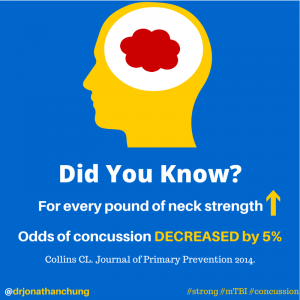Ask the Docs

Helmets Can’t Stop Concussions, but this can….
By Dr. Jonathon Chung
See the video! https://youtu.be/hXHyk24rAbM
This past weekend I had the opportunity to attend the Minnesota Concussion Summit. What was unique about this seminar was that it wasn’t geared towards doctors like neurologists or neurosurgeons who are usually responsible for the medical care of concussion patients. It was actually geared towards coaches, fitness professionals, physical therapists, and athletic trainers who work most heavily with the population at highest risk for concussion – the youth athlete.
While doctors need to be focused on effective treatment and therapy for the concussed patient, there are numerous professionals that are in a uniquely suited position to help PREVENT head injury from happening in the first place. The main problem with concussion prevention programs is that the focus on technological improvements on athlete equipment has produced little to no results.
Lesson 1: Helmets Can’t Prevent Brain Injury
When most people think about concussion prevention, you usually think about the quality of helmet that can be used. Helmets are lighter and tougher than ever, and they are subject to rigorous laboratory testing. Intuitively, it makes sense that protecting the brain should start with the hard hat.
Here’s the truth. Helmets were designed for one purpose: to stop skull fractures. To that end, helmets are doing a remarkable job, as almost no one playing football or hockey have been diagnosed with skull fractures since helmets became modernized.
However, in the wake of the growing national concern with concussions and head safety, improvements in helmet technology have been marketed as the tool for concussion prevention. The truth is that helmets are limited in their ability to stop concussions because helmets can’t stop the brain from moving.
While direct helmet to helmet contact is likely the easiest way to sustain a concussion, there’s no doubt that a serious hit can put tremendous acceleration forces into the neck, head, and brain. As we’ve seen in many cases of concussion from whiplash, your head doesn’t need to make physical contact to create damage to the brain.
Additionally, there are those who make the case that improved helmets have led to an increase in those bone shaking hits we tend to cheer for as football fans. Because the helmet has become so effective in protecting players from damage to the skull, it has turned into a weapon to make hits more brutal.
Bigger hits = faster head acceleration = more brain damage
Lesson 2: Stronger Necks May Help
Most concussion research has been focused on what’s happening to the head, but a few studies have shown that the answer to prevention may be in the neck.
Here are links to a few studies that show that increasing neck strength may play a role in reducing someone’s odds of having a concussion:
Neck strength: a protective factor reducing the risk of concussion in high school sports.
The influence of cervical muscle characteristics on head impact biomechanics in football.
When someone has strength in the musculature of their neck, they have an increased ability to produce stiffness and resist acceleration of the head. This accomplishes two things:
Stiffer, stronger necks prevent head movement which will prevent movement of the brain. Stiffer, stronger necks can prevent damage to the ligaments and soft tissues that support the neck.
Most of us will do anything possible to rid ourselves of neck stiffness, so the thought of training the neck seems terrible. However, it may be a key component to protecting athletes from the devastating effects of head and neck injury.
Big Hits Get Most Scrutiny But Small Hits in Youth Athletes are at Greatest Risk
So let’s be honest. Some of these big hits that we see on TV are likely to cause a concussion regardless of how strong someone’s neck is. The same thing can be said for things like a hard helmet to helmet collision. While professional athletes NEED to get their necks stronger just to handle the rigors of their sport, having appropriate neck strength may ensure that some of these big hits won’t cause fracture or neck dislocation. If it doesn’t prevent concussion, neck strength may save their life.
See the video! https://youtu.be/Vf-qgqLqzds
The important thing to remember is that MOST concussions happening now are not a result of huge direct hits seen in professional football and hockey. Most concussions are happening in our backyards.
- They happen when girls collide while going for a header in soccer.
- They happen when you get into a car accident on the way to work.
- They happen to normal people when they fall while riding a horse.
These common and seemingly harmless activities are where a bulk of head injuries happen today and these are the places where improving neck strength can make the biggest difference.
Conclusion
At Keystone Chiropractic, we are happy to report that our office is undergoing certification in evidence-based neck strengthening methods to help reduce head and neck injury. If you want to learn more, please feel free to reach out to us and talk about how we can develop a strength program for the neck and protect the health of yourselves or your athletes.
Did you like this article? Feel free to share it with the people you care about and see if a Complimentary Consultation is the next step to regain their health.
Dr. Chung is a practicing Structural Chiropractor in the West Palm Beach area. He has been published in peer reviewed scientific journals and is a sought after speaker in health and wellness. Follow his blog at http://chiropractorwellington.com/category/keystone-chiropractic-blog/ or find him on twitter at @drjonathanchung.


